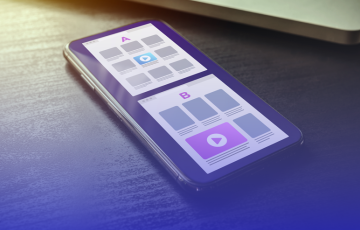
How to roll out your personalization experiments
Every personalization project is a chance for brands to develop a better understanding of their visitors’ needs and behavior.
That means that the depth and precision of your targeting, and the variety of actions and customizable elements on your website are both very important criteria when you are creating tailored online experiences for your audience segments.
To successfully roll out a large-scale online personalization strategy, it’s also vital to use a rigorous method and framework. What steps should you follow to provide relevant personalized experiences aligned with your business goals?
Based on our experience, we recommend this approach.
1 Set the goals and use cases for each of your personalization experiments
Personalization is a broad concept. While it covers adapting your website to meet the expectations of individual visitors, it doesn’t imply the same thing for all brands. So first and foremost, you must define what personalization means for your company.
Start by identifying your personalization needs, taking into account your industry context and business goals.
This will enable you to identify:
- the technology and human resources needed to successfully implement your strategy
- the key KPIs you need to monitor to confirm your hypotheses and track results.
1. YOUR MAIN GOAL
Start by clearly establishing the main business goal of your personalization strategy. Essentially, why do you wish to deploy a personalization strategy?
These are example main goals:
- Increase conversions
- Improve visitor engagement
- Increase customer loyalty
- Reduce churn
The KPIs that you use to monitor and analyze the performance of your personalization come directly from your goal.
For example, if you want to increase conversions, the main KPIs will be add-to-cart, number of confirmed purchases, return rate, etc. If your goal is to increase engagement, KPIs will be time spent on page, number of pages viewed, account-creation rate, etc.
2. PERSONALIZATION USE CASES: WHAT ACTIONS CAN YOU IMPLEMENT TO ACHIEVE YOUR GOAL?
Once your goal is clear, you must decide on the actions you take to achieve it.
Your use cases will be based on how your industry operates and on your website itself. To identify them, get to know your audience by analyzing visitor behavior and how they react to the experiences you offer them.
Two brands can have the same personalization goal (for example, to increase average cart value), yet roll out different use cases.
Identify your use case
What? : Decide what element you want to personalize or create to provide a personalized experience: A pop-in? A banner? Changing an element on a page?
Où ? : Identify the locations and triggers that push your visitors to convert, to determine exactly where you’re going to run your personalized actions: On the home page? On a product information page? Or across your website’s navigation?
Where? : Identify the key moments for triggering your personalizations: when visitors arrive on the website? when they leave the website? once they’ve viewed a certain number of pages?
How? :
You can trigger a range of actions:
- Content personalization: Highlight the most relevant content for your visitors depending on their interests and needs when they arrive on your website. There are various means of highlighting personalized content such as modifying pre-existing content, adding new content or modifying/adding a banner.
- Message personalization: Trigger marketing or sales messages in real-time. Personalized messages are dynamically displayed depending on visitor behavior.
- On-site merchandise personalization: Reorganize the products displayed to each visitor based on the items or price categories they view (highlighting products based on the visitor’s purchasing power, targeting only certain products, social proof, or urgency, for example).
- Navigation personalization: Adapt the visitor’s journey on your website based on their habits, to enhance their experience and encourage them to convert more naturally (for example, highlighting the product categories most viewed by the visitor or reorganizing your website’s sections and menu, etc.)
- Email personalization: Automate the sending of emails containing product recommendations, or triggered after they leave the site or abandon a cart. You just need to define the triggers and sending conditions in advance.
- Retargeting ad personalization: Personalize retargeting ads displayed to your visitors after they’ve been to your website.
If you are a media website
The goal of a media website is to build a database of visitors and then create loyalty, encouraging them to return and consume the maximum amount of content, sign up for a paid subscription or be exposed to advertising.
- What are your goals? Increase engagement, the number of sign-ups for a paid subscription, sign-ups for the newsletter; reduce the unsubscribe rate.
- What are your use cases? Optimize the home page based on a visitor’s interests; offer newsletter sign-up to qualified visitors at the right moment; or reorganize the menu based on preferred content.
If you are an e-commerce website
The goal of an e-commerce website is to increase conversion rates and build loyalty so customers return to the website regularly and convert again.
- What are yout goals? Increase the number of purchases, boost average cart value, and reduce cart abandonment.
- What are your use cases? Personalize the home page according to preferences, offer product recommendations, reorganize navigation based on preferred product categories or send personalized emails in the event of cart abandonment or visits without conversion.
If you are an automotive website
The goal of an automotive website is to turn visitors into loyal customers but also send them towards another channel to make the sale (telephone, dealership).
- What are your goals? Increase engagement to encourage visitors to return to the website and identify the models they like; send qualified leads to dealerships.
- What are your use cases? Personalize the content according to the vehicle that interests the visitor; suggest a free test drive at dealerships to visitors who are very interested.
2 Identify the target for your personalization experiment
Before beginning personalization, you must identify the key segments you want to focus on. What are your target segments? How do your website visitors in these sectors behave?
Collect the right data
The goal of personalization is to provide visitors with contextualized experiences based on their preferences, behavior, previous visits or purchases. To do this, you must use all the data at your disposal.
Two types of data to collect:
- Hot data: this will give you information about the behavior of visitors on your website, such as time spent, pages viewed, geolocation, type of device, browser.
- Cold data: this is all the data from your CRM or DMP, like purchase frequency, value of last cart, loyalty program membership.
Identify the targeT
Next, you must decide which visitors will be exposed to your personalization.
To do this, you must analyze your data and identify the segments that have high added value for you, i.e. those for which a personalized experience could trigger or increase conversion.
Manual segmentation
With manual segmentation, you define criteria in advance to create your segments. For example: visitors who have visited three bike product pages, or based on their location.
This approach can be appropriate for simple personalizations but can quickly fall short if you wish to provide more sophisticated, real-time experiences on your website.
AI-driven segmentation
Depending on how complex it is to define your target, it could well be better to embrace artificial intelligence, which enables you to identify the optimal target for your actions.
Machine learning algorithms can reproduce the behavior of an in-store sales advisor observing and listening to their customers, on your website. These algorithms collect hot data in real-time and learn from behavior to then find correlations between visitors.
This allows you to identify visitor segments that would be impossible to define manually. For example:
- Visitors showing an interest in one product rather than another
- Visitors with a high conversion probability
- Undecided visitors
So, if you want to offer a promotion on a certain type of product to the most interested customers, AI can enable you to identify this target and achieve your goals.
3 Roll out and manage your personalization experiments
Now it’s time to take action and roll out your personalization. To do this, you’ll have to design the graphic elements that will be part of your experiment, but also determine how they’ll be triggered.
1. Devise the experiments
After identifying your use case and the target for your personalization, you must create the experiment on your website. The personalized element must follow your visual brand identity and naturally blend in with the rest of the elements.
With Kameleoon, for example, there are several solutions for creating your experiments:
- through the easy-to-use graphic editor
- by choosing a widget from our library
- by coding the modifications via our code editor
- by coding the entire experiment server-side via your usual development environment.
2. Storyboard your experiments
For the experience on your website to be enticing, you must storyboard your personalization, i.e. determine the context surrounding your pop-in or banner.
It’s not enough to create an experiment and display it on your website - you need to consider the overall visitor experience:
- when a visitor arrives on your website, they may belong to several segments and therefore be targeted by several experiments. So it is important for you to think through potential scenarios, taking into account all the elements that could be added to your personalization to manage marketing pressure.
- The personalization you’ve devised will not necessarily be relevant all the time - you must determine when it should appear on your website.
To enable you to trigger experiences that really correspond to the profile of your visitors, the Kameleoon platform offers several solutions to help you set the right exposure level:
- Capping enables you to limit the display of your personalization to manage the marketing pressure exerted on your visitors. You can set a minimum time delay between two exposures, and prioritize the display of one personalization rather than another if a visitor meets the targeting conditions of two different experiments.
- Storyboarding enables you to add conditions to trigger your experiment based on previously displayed personalizations.
- Scheduling enables you to set date ranges for displaying your personalization. This means you can display your experiments at very specific times.
- Prioritization enables you to determine a priority order for your personalizations in the event a visitor fits the targeting criteria of several experiments. So if you decide that visitors can only be exposed to a single experiment, prioritization enables you to define which one will be displayed.
4 Analyze the results and adapt your personalization experiments
Finally, you must analyze your results and adjust your experiences if necessary so they are perfectly suited to your visitors’ journeys and enable you to achieve your goals.
For example, take a sports brand. To increase sales you want to use personalization to offer discount codes for visitors interested in the bike category on your site.
The KPIs to monitor are:
- the click rate on the pop-in
- the discount code redemption rate
- the purchase rate in the bike department.
You note that there is a high click rate on the pop-in, but that not many visitors are using the discount code. How can you resolve this?
You can work on the targeting (for example, widen the targeting of visitors who see the personalization) or on the relevance of the experiment (changing the value of the discount code or even the way you present it to visitors).
Kameleoon’s personalization platform has a reporting page for your personalization experiments that enables you to analyze all these elements by offering different views by goal, by audience type or personalized to your own requirements. You can also create custom alerts so that you can immediately react and adapt personalizations if a metric decreases or increases.
You must develop a rigorous methodology if you want your personalizations to be relevant and delivered in an optimal manner. Once you’ve set your goals, you can devise which personalizations to run and the visitors you want to target. Finally, to keep your strategy on track and to keep stakeholders informed, it’s vital to analyze your results, learn from them and keep improving your program.





